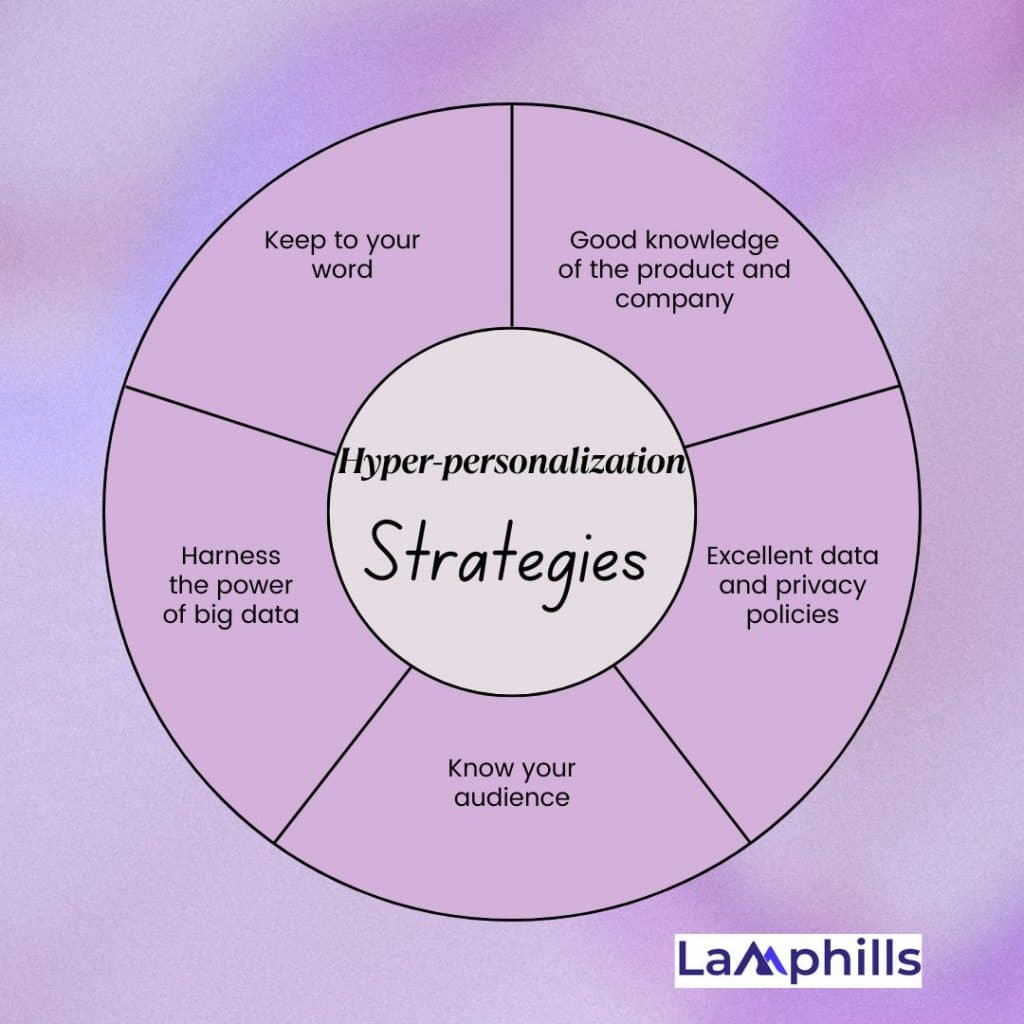Today’s consumers are bombarded with messages from brands, even ones they don’t follow. Many companies say they “personalize” interactions, but what do they even mean by that? Is it just adding a customer’s name to a message or recommending the next product in line? Some companies tailor offers based on demographics or marketing personas. However, not everybody in the same area has the same preferences or buying habits. Simple personalization isn’t enough to keep your customers loyal and engaged. You have to do more, and that’s where hyper-personalization comes in. Here’s all you need to know.
Key Points
- Hyper-personalization is a type of marketing that leverages artificial intelligence (AI) and real-time data to produce highly granular, customer-specific products, services, or content.
- An effective hyper-personalization strategy involves having a good knowledge of the product and company, excellent data and privacy policies, knowing your audience, harnessing the power of big data, and keeping to your word.
What is Hyper-Personalization?
Hyper-personalization, also known as one-to-one marketing, is a type of marketing that leverages artificial intelligence (AI) and real-time data to produce highly granular, customer-specific products, services, or content. Typically, this process is automated, but it can also happen in person. One example of hyper-personalization is customized social media ads that offer custom hair solutions. After completing a brief online quiz, customers are given the option to purchase a super-bespoke concoction that will permanently banish bad hair days for their particular hair needs.
Consumers across all industries have plenty of options. Amid those options, they are looking for goods and services that will cater to their personal needs or at least make their purchasing experience spectacular. If you want to stand out in your industry and achieve brand loyalty, you have to brush up on your hyper-personalization plan.
This video summarizes the whole essence of hyper-personalization:
What Makes Hyper-Personalization Different from Traditional Personalization?
A typical traditional personalization strategy involves adding a person’s first or last name to a standard email, such as “Dear (first name)” and a standard message. Hyper-personalization uses a different strategy altogether. It leverages the power of AI and machine learning (ML), in addition to other devices powered by the Internet of Things (IoT). These tools garner a large amount of data about every customer interaction to build a thorough profile of that customer. It enables the seller to know, for instance, at what times of day a customer is likely to be online or scrolling through Facebook and when to time their ads accordingly. Also, it helps brands accurately time their push notifications to increase the chances of the customer acting on them.
Here’s the main difference: traditional personalization will show ads based on your previous purchase and probably what other people in your demographic are buying. On the other hand, hyper-personalization will leverage all the data from your earlier purchases to determine your preferences and create an ad specifically for you. This seems like a pretty long process, right? Well, that’s why you use AI tools to streamline the process.
Essential elements of a hyper-personalization strategy

Now, there are some essential elements you should implement to really excel with a hyper-personalization strategy. They include:
#1. Good knowledge of the product and company
You’re aiming to treat every visitor to your store or site as a unique entity, but you can’t really achieve that if you don’t have an in-depth knowledge of what your company has to offer. As a marketer, you should know everything about your products or services, logistics, USPs, etc. This will help you to craft a tailored and comprehensive message.
#2. Excellent data and privacy policies
Your customers should know they can trust you with their personal data, not minding how you obtained it. Your company has to be transparent with your policy on data.
#3. Know your audience
Use insights from the data collected from your visitors to build a comprehensive profile of your visitors and segment them into various groups based on their characteristics. This will help you generate content that resonates with their personalities and ultimately drives them to buy.
#4. Harness the power of big data
Use analytics and data mapping to create a hyper-personalization framework that helps you deliver the best buying experiences to your customers.
#5. Keep to your word
Have resources that will help you implement your strategy seamlessly and then deliver on your promise once the purchase has been made.
The Benefits of Hyper-personalization
Hyper-personalization has a lot of benefits for customers and marketers alike. Here are some of the benefits of hyper-personalization to customers:
- Hyper-personalization helps products get to customers faster, relieving them of the stress of going through different pain points to get what they want.
- Hyper-personalization shortens sales cycles.
- Hyper-personalization reduces customer stress. Instead of overwhelming them with a wide range of products, provide them with a tailored selection of items likely to appeal to them. This improves the chances of purchasing.
How Does Hyper-personalization Benefit Retailers?

There is a direct line between providing a hyper-personalized experience for the customer and seeing an increased GMROI. Here are some ways the retailer can benefit from hyper-personalization:
#1. Increased profits
Of course, the goal of every marketing strategy is to increase profits. Hyper-personalization can help you generate 40% more revenue than any other marketing strategy. Why? Customers will more likely purchase from companies that provide personalized experiences.
#2. Differentiation in the marketplace
Competitors can hardly duplicate a highly personalized customer experience using proprietary data. Hyper-personalization makes your company stand out. Another advantage is that as more data is collected and built upon, AI-based software becomes more knowledgeable; providing you with the information you need to make more insightful data-based decisions about your customers.
#3. Increases Customer loyalty
Almost everybody appreciates that feeling of a friendly, warm, knowledgeable salesperson familiar with you and your needs. That salesperson learns your needs as a customer and can even predict those needs in the future.
If done right, you can “capture” the essence of that friendly salesperson with hyper-personalization. It’s something leading retailers want to achieve because 84% of consumers say being treated like a person, not a number, is crucial to winning their business.
If you can fill your customers’ needs and offer them their preferred products, you will ultimately win their loyalty.
Read Also: 7 Simple Practical Steps to Build Brand Loyalty
The Challenges of Hyper-personalization
Every marketing strategy has challenges, but there will always be ways to go about them. One of the challenges with hyper-personalization is the cost of implementing one. Hyper-personalization is time-consuming, and trying to achieve that degree of granularity can be expensive. Another dilemma for marketers is deciding when to deploy personalization strategies in the customer life cycle. You can do this on two occasions:
- When you have all the data you need though there has been no direct interaction between your company and the target customer(s)
- After an actual personal interaction between your company and the customer, the customer has consciously provided information.
Finally, customers can feel somehow insecure about technology that reads into personality traits, online behavior, and digital footprints, predicting their next move before they know what it will be. You can reduce this insecurity with permission-based hyper-personalization.
Note that for your hyper-personalization strategy to be effective, your approach must be carefully thought out and should benefit your company as much as it does the customers.
Examples of Companies That Have Succeeded With Hyper-Personalization
Many well-known companies across various industries have achieved significant results with hyper-personalization. Here are some of them:
#1. Wells Fargo
With over 70 million customers, Wells Fargo struggled to personalize their day-to-day engagement, requiring them to connect and analyze billions of digital interactions in real-time. The company decided to leverage the Pega Customer Decision Hub™ to drive the transformation necessary for personalization by providing real-time modeling and adaptive machine learning. With the solution in place, the bank can constantly recalculate each individual’s “next best conversation,” while those individuals are interacting with the brand. Wells Fargo can now analyze four billion digital interactions to identify each individual’s “next best conversation” and successfully personalize messages and experiences for 70 million customers.
#2. Netflix

Netflix is renowned for its hyper-personalized recommendation engine, which suggests movies and TV shows based on users’ viewing history, preferences, and behavior. By analyzing user data, Netflix provides highly tailored content recommendations, increasing user engagement and satisfaction.
#3. Amazon
Amazon incorporates hyper-personalization throughout its platform, from personalized product recommendations to customized marketing emails. By leveraging customer data such as browsing history, purchase behavior, and demographic information, Amazon delivers a personalized shopping experience that enhances customer loyalty and drives sales.
#4. Nike

Nike’s NikeID platform allows customers to customize their sneakers with personalized colors, materials, and designs. By empowering customers to create unique and customized products, Nike enhances brand loyalty and customer satisfaction, driving sales and advocacy.
These companies demonstrate the power of hyper-personalization in delivering tailored experiences that meet individual customers’ unique needs and preferences, ultimately driving customer satisfaction, loyalty, and business success.
Future Trends and Opportunities
As technology advances at an unprecedented pace, the future of marketing is shaped by emerging hyper-personalisation trends. Businesses can leverage AI and machine learning to create truly personalized experiences that resonate with consumers on a deeper level.
AI and Machine Learning
Hyper-personalization powered by artificial intelligence promises a world where every interaction with a brand feels tailored to your unique preferences and needs. These cutting-edge technologies enable businesses to analyze vast amounts of data in real-time, enabling the creation of highly personalized experiences at scale.
Opportunities for Innovation and Differentiation
Hyper-personalization offers businesses a unique opportunity to innovate and differentiate themselves by delivering tailored experiences that speak directly to their customer’s individual preferences and needs.
Leveraging AI and Machine Learning for Hyper-Personalization
AI and machine learning are revolutionizing the way businesses approach hyper-personalization. By harnessing the power of predictive analytics, natural language processing, and deep learning algorithms, companies can gain valuable insights into consumer behavior and preferences, allowing them to deliver targeted messaging and recommendations in real time.
We implemented AI-powered chatbots while working with a digital marketing agency to enhance our client’s customer service experience. These intelligent bots could engage with customers in natural language, providing personalized assistance and product recommendations based on their browsing history and previous interactions. The result? A significant increase in customer satisfaction and sales conversions.
Is Uber a Hyper-personalized Model?
Yes, Uber employs hyper-personalization through its app, offering tailored experiences based on user preferences, location, ride history, and feedback.
What Is The Hyper-personalization Strategy of Starbucks?
Starbucks utilizes customer data from its app and rewards program to offer personalized recommendations, promotions, and special offers tailored to individual preferences and purchasing behaviors.
What Is Hyper-personalization in HR?
Hyper-personalization in HR involves customizing employee experiences, from recruitment to development, using data-driven insights to meet individual needs and preferences.
Is Hyper-personalization the Same as Segmentation?
Hyper-personalization goes beyond segmentation. While segmentation divides audiences into groups based on shared traits, hyper-personalization tailors experiences to individual preferences and behaviors, offering unique content and recommendations for each person.
What Is The Difference Between Personalization and Hyper-personalization?
Personalization tailors content to broad audience segments, while hyper-personalization uses AI and real-time data to create individualized experiences for each user.
In Conclusion,
A single moment can mean everything to your customers, and you can only imagine what it will be like for them if their needs are met in real-time. That’s the real power of hyper-personalization, the ability to create highly relevant customer interactions based on their unique needs, characteristics, and behaviors – from product recommendations to real-time personalized experiences and beyond.
Related Articles
- Marketing vs. Advertising: Building a Growth Engine for Your Business
- What Is A Contact Database? A Guide to Building Your Own
- BROADCAST MEDIA: Best Practices In 2024 (Updated!)
- What Does Integrated Communications Marketing Do For Your Business: All You Need To Know






